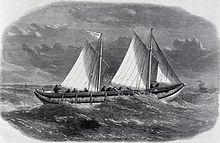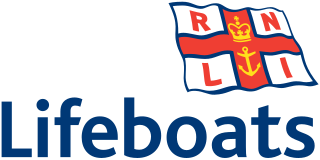
The Royal National Lifeboat Institution (RNLI) is the largest of the lifeboat services operating around the coasts of the United Kingdom, the Republic of Ireland, the Channel Islands, and the Isle of Man, as well as on some inland waterways.
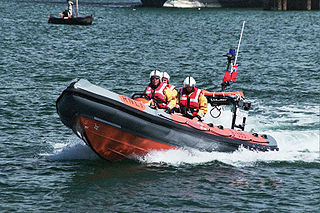
A rigid inflatable boat (RIB), also rigid-hull inflatable boat or rigid-hulled inflatable boat (RHIB), is a lightweight but high-performance and high-capacity boat constructed with a rigid hull bottom joined to side-forming air tubes that are inflated with air to a high pressure so as to give the sides resilient rigidity along the boat's topsides. The design is stable, light, fast and seaworthy. The inflated collar acts as a life jacket, ensuring that the vessel retains its buoyancy, even if the boat is taking on water. The RIB is an evolutionary development of the inflatable boat with a rubberized fabric bottom that is stiffened with flat boards within the collar to form the deck or floor of the boat.

The Severn class is the largest lifeboat operated by the Royal National Lifeboat Institution (RNLI). The class, which is 17.3 metres long, was introduced in to service in 1996. It is named after the River Severn, the longest river in Great Britain. The lifeboats are stationed at 35 locations around the coasts of the United Kingdom and Ireland and can provide coverage up to 125 nmi (232 km) out to sea.

Mersey-class lifeboats are All-weather lifeboats operated by the Royal National Lifeboat Institution (RNLI) from stations around the coasts of Great Britain and Ireland, with three former RNLI boats operated by ADES Uruguay, and one by Bote Salvavidas de Valparaiso, Chile. They are capable of operating at up to 17 knots (31 km/h) and can be launched from a carriage or by slipway.

The D-class (EA16) lifeboat is a class of inflatable boat operated since 1987 by the Royal National Lifeboat Institution of the United Kingdom and Ireland. It has been replaced operationally by the D-class (IB1), but many are still used as part of the relief fleet, as boarding boats for the larger classes of lifeboat and by the RNLI Flood Rescue Team.

The D-class (IB1) lifeboats are inflatable boats serving in the RNLI inshore lifeboat (ILB) fleet as well as a number of Independent Lifeboats around the UK and Ireland. Although they are known as the "IB1" at times, they are the latest development of the D-class lifeboat and as such are mainly referred to as a "D-class".
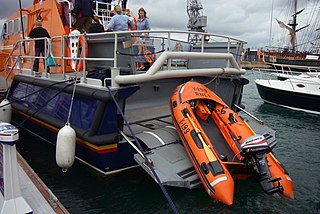
The Y-class lifeboat is a class of small inflatable rescue boat operated by the Royal National Lifeboat Institution of the United Kingdom and Ireland.

The Arancia-class inshore rescue craft is a class of small inflatable rescue boat (IRB) operated by, among others, Surf Lifesaving Great Britain, Surf Life Saving Association of Wales and the Royal National Lifeboat Institution (RNLI) of the United Kingdom and Ireland.
A rescue lifeboat is a boat rescue craft which is used to attend a vessel in distress, or its survivors, to rescue crew and passengers. It can be hand pulled, sail powered or powered by an engine. Lifeboats may be rigid, inflatable or rigid-inflatable combination-hulled vessels.

Atlantic College Lifeboat Station was an inshore lifeboat station based at the United World College of the Atlantic on the coast of South Wales, responsible for rescues in the challenging waters of the Bristol Channel.
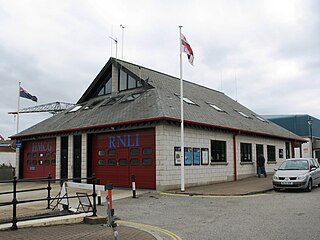
Falmouth Lifeboat Station is the base for Royal National Lifeboat Institution (RNLI) search and rescue operations at Falmouth, Cornwall in the United Kingdom. The first lifeboat was stationed in the town in 1867 and the present station was opened in 1993. It operates a Severn Class all-weather Lifeboat (ALB) and an Atlantic 85 inshore lifeboat (ILB).

Newhaven Lifeboat Station is an RNLI station located in the town of Newhaven in the English county of East Sussex in the United Kingdom. The original station was established in 1803 and taken over by the RNLI in 1854.

Eastbourne Lifeboat Station is a Royal National Lifeboat Institution (RNLI) lifeboat station in the town of Eastbourne in East Sussex. Founded two years before the RNLI was established, the station has operated continuously since 1822 and its lifeboats have been responsible for saving over 700 lives. There are two active lifeboat stations in Eastbourne, an all-weather station with the Trent-class 14-02 Esme Anderson at Sovereign Harbour and the D-class (IB1) The David H (D-876) at the inshore lifeboat station a couple of miles to the west at Fisherman's Green. An older lifeboat station, west of Eastbourne Pier, is now used as an RNLI museum.
The D-class lifeboat was a sub-class of 4 inflatable boats operated as part of the D-class between 1971 and 1986 by the Royal National Lifeboat Institution of the United Kingdom and Ireland. It was superseded by the D-class lifeboat.

Barmouth Lifeboat Station is located in Barmouth, a town at the mouth of the Afon Mawddach river in Gwynedd, Wales. A lifeboat was first stationed here by the Royal National Institute for the Preservation of Life from Shipwreck (RNIPLS) in 1828.
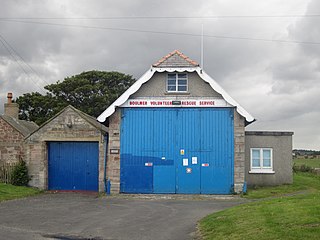
Boulmer Lifeboat Station is a former Royal National Lifeboat Institution (RNLI) station, which was located at the village of Boulmer in the county of Northumberland.

Tynemouth Lifeboat Station is located on the River Tyne, at Fish Quay, North Shields, in the county of Tyne and Wear.
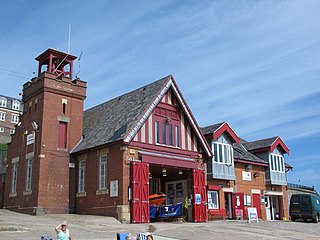
Cullercoats Lifeboat Station is located on the north side of Cullercoats Harbour, in the town of Cullercoats, North Tyneside, in the county of Tyne and Wear.
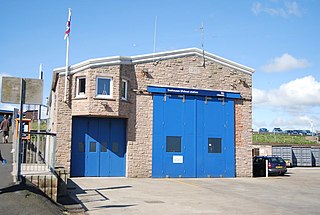
Seahouses Lifeboat Station is located in the village of Seahouses, in the county of Northumberland.

